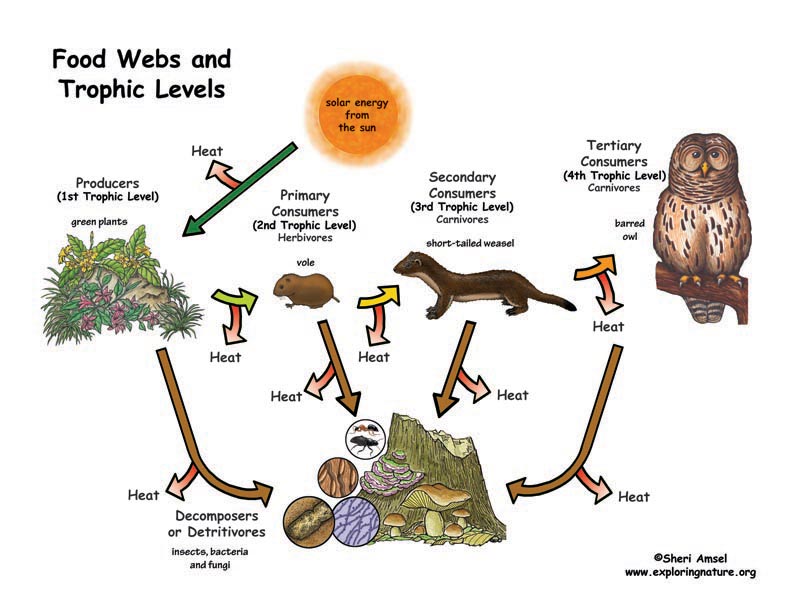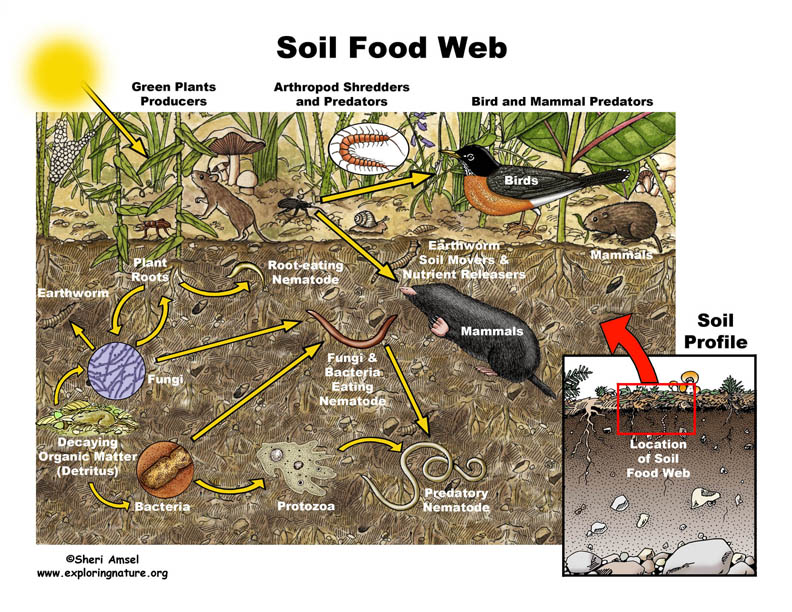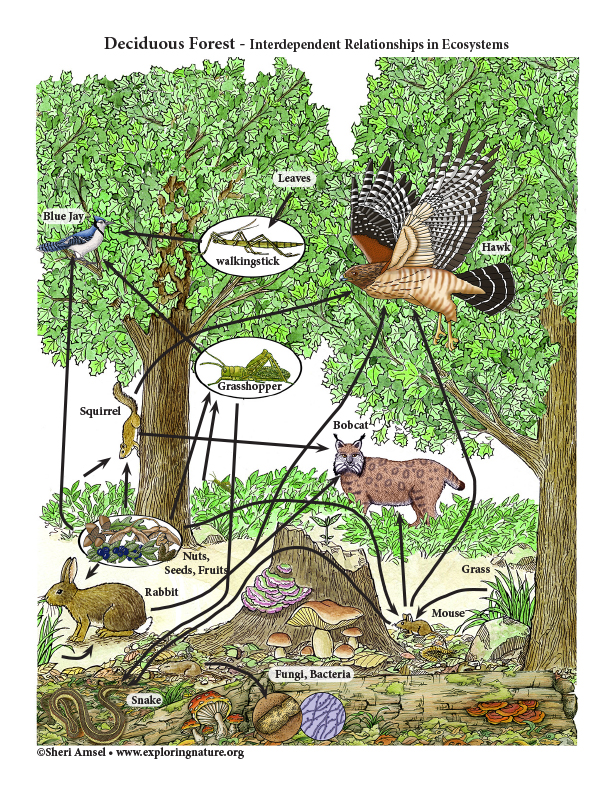

Disciplinary Core Ideas
LS2.A: Interdependent Relationships in Ecosystems
• Organisms, and populations of organisms, are dependent on their environmental interactions both with other living things and with nonliving factors. (MS-LS2-1)
• In any ecosystem, organisms and populations with similar requirements for food, water, oxygen, or other resources may compete with each other for limited resources, access to which consequently constrains their growth and reproduction. (MS-LS2-1)
• Growth of organisms and population increases are limited by access to resources. (MS-LS2-1)
• Similarly, predatory interactions may reduce the number of organisms or eliminate whole populations of organisms. Mutually beneficial interactions, in contrast, may become so interdependent that each organism requires the other for survival. Although the species involved in these competitive, predatory, and mutually beneficial interactions vary across ecosystems, the patterns of interactions of organisms with their environments, both living and nonliving, are shared. (MS-LS2-2)
LS2.B: Cycle of Matter and Energy Transfer in Ecosystems
• Food webs are models that demonstrate how matter and energy is transferred between producers, consumers, and decomposers as the three groups interact within an ecosystem. Transfers of matter into and out of the physical environment occur at every level. Decomposers recycle nutrients from dead plant or animal matter back to the soil in terrestrial environments or to the water in aquatic environments. The atoms that make up the organisms in an ecosystem are cycled repeatedly between the living and nonliving parts of the ecosystem. (MS-LS2-3)
____________________________________________________________________________________________________________________________
Use the Template and Resource Links to Fulfill NGSS
l. Goals:
Essential Questions:
NGSS Note: Think, question, entertain ideas.
ll. Introductory Activities to Assess Prior Knowledge
A. Simple Activities - that assess students’ understanding of food webs, competition for resources, predator-prey relationships, mutualism, biodiversoty and health of ecosystems.
B. Brainstorming Sessions
Question: What are some ways organisms become dependent on each other and the nonliving things in an ecosystem?
1. Break students down into groups of 3-4.
2. Ask students to generate a list of the different ways organisms become dependent on each other and the nonliving things in an ecosystem (i.e. for food, shelter, seed dispersal, etc.). Give some examples to think about, such as squirrels that collect acorns and by burying them has food for winter survival and also helps the oak tree plant its seeds.
3. Discuss
Yellowstone Wolf Project - Effects of Resource Availability
Yellowstone Wolf Project - Population Study and Graphing Task
Resource Availability in Food Webs - Critical Thinking
lll. New Knowledge - Text
A. Read about foodwebs:
Food Webs - The Nutrient Cycle
About Food Webs and Trophic Levels
Soil Food Web
Cycling of Matter in the Soil
Cycles of Matter and Energy Transfer in Ecosystems
Read about how plants depend on animals and nonliving resources to help spread their pollen and seeds:
Plant Adaptations for Pollination & Seed Dispersal
Read about Keystone Species - how organisms "are dependent on their environmental interactions both with other living things and with nonliving factors" in their ecosystem:
Sea Otters
Sharks
African Elephants
American Alligator
B. Examples of Models (depicts the concept expressed in the reading):
Ask students to look at the models and explain how each illustrates the concepts they've read about.
A. Inquiry related to above topics:
Study the competition between a population of plants: What Grows Here? Inquiry-based Plant Activity
Study how plants depend on animals and nonliving resources to help spread their seeds: Seed Dispersal - An Investigation
B. Authentic Performance - Understanding by Design (UbD) assessment tool.
Use critical thinking to complete thse Authentic Performance Activities and deepen your understanding about the above topics.
C. Critical Thinking Activities related to food webs:
Building a Forest Food Web Activity
Name the Parts of a Food Web
Trophic Levels - Graphic Organizer
V. Summarize Knowledge - Enduring Understandings
Vl. New Generation of Science Standards (NGSS) - Middle School Life Science
Disciplinary Core Ideas
LS2.A: Interdependent Relationships in Ecosystems
• Organisms, and populations of organisms, are dependent on their environmental interactions both with other living things and with nonliving factors. (MS-LS2-1)
• In any ecosystem, organisms and populations with similar requirements for food, water, oxygen, or other resources may compete with each other for limited resources, access to which consequently constrains their growth and reproduction. (MS-LS2-1)
• Growth of organisms and population increases are limited by access to resources. (MS-LS2-1)
• Similarly, predatory interactions may reduce the number of organisms or eliminate whole populations of organisms. Mutually beneficial interactions, in contrast, may become so interdependent that each organism requires the other for survival. Although the species involved in these competitive, predatory, and mutually beneficial interactions vary across ecosystems, the patterns of interactions of organisms with their environments, both living and nonliving, are shared. (MS-LS2-2)
LS2.B: Cycle of Matter and Energy Transfer in Ecosystems
• Food webs are models that demonstrate how matter and energy is transferred between producers, consumers, and decomposers as the three groups interact within an ecosystem. Transfers of matter into and out of the physical environment occur at every level. Decomposers recycle nutrients from dead plant or animal matter back to the soil in terrestrial environments or to the water in aquatic environments. The atoms that make up the organisms in an ecosystem are cycled repeatedly between the living and nonliving parts of the ecosystem. (MS-LS2-3)
LS2.C: Ecosystem Dynamics, Functioning, and Resilience
• Ecosystems are dynamic in nature; their characteristics can vary over time. Disruptions to any physical or biological component of an ecosystem can lead to shifts in all its populations. (MS-LS2-4)
• Biodiversity describes the variety of species found in Earth’s terrestrial and oceanic ecosystems. The completeness or integrity of an ecosystem’s biodiversity is often used as a measure of its health. (MS-LS2-5)
LS4.D: Biodiversity and Humans
• Changes in biodiversity can influence humans’ resources, such as food, energy, and medicines, as well as ecosystem services that humans rely on—for example, water purification and recycling. (secondary to MS-LS2-5)
ETS1.B: Developing Possible Solutions
• There are systematic processes for evaluating solutions with respect to how well they meet the criteria and constraints of a problem. (secondary to MS-LS2-5)
Science and Engineering Practices (NGSS)
Developing and Using Models
Modeling in 6–8 builds on K–5 experiences and progresses to developing, using, and revising models to describe, test, and predict more abstract phenomena and design systems.
• Develop and use a model to describe phenomena. (MS-LS2-3)
Analyzing and Interpreting Data
•Analyzing data in 6–8 builds on K–5 experiences and progresses to extending quantitative analysis to investigations, distinguishing between correlation and causation, and basic statistical techniques of data and error analysis.
• Analyze and interpret data to provide evidence for phenomena. (MS-LS2-1)
Constructing Explanations and Designing Solutions
Constructing explanations and designing solutions in 6–8 builds on K–5 experiences and progresses to include constructing explanations and designing solutions supported by multiple sources of evidence consistent with scientific ideas, principles, and theories.
• Construct an explanation that includes qualitative or quantitative relationships between variables that predict phenomena. (MS-LS2-2)
Engaging in Argument from Evidence
Engaging in argument from evidence in 6–8 builds on K–5 experiences and progresses to constructing a convincing argument that supports or refutes claims for either explanations or solutions about the natural and designed world(s).
• Construct an oral and written argument supported by empirical evidence and scientific reasoning to support or refute an explanation or a model for a phenomenon or a solution to a problem. (MS-LS2-4)
• Evaluate competing design solutions based on jointly developed and agreed-upon design criteria. (MS-LS2-5)
Connections of Nature and Science
Scientific Knowledge is Based on Empirical Evidence
• Science disciplines share common rules of obtaining and evaluating empirical evidence. (MS-LS2-4)
Crosscutting Concepts (NGSS)
Patterns
• Patterns can be used to identify cause and effect relationships. (MS-LS2-2)
Cause and Effect
• Cause and effect relationships may be used to predict phenomena in natural systems. (MS-LS1-8)
• Phenomena may have more than one cause, and some cause and effect relationships in systems can only be described using probability. (MS-LS1-4),(MS-LS1-5)
Scale, Proportion, and Quantity
• Phenomena that can be observed at one scale may not be observable at another scale. (MS-LS1-1)
Systems and System Models
• Systems may interact with other systems; they may have sub-systems and be a part of larger complex systems. (MS-LS1-3)
Energy and Matter
• Matter is conserved because atoms are conserved in physical and chemical processes. (MS-LS1-7)
• Within a natural system, the transfer of energy drives the motion and/or cycling of matter. (MS-LS1-6)
Structure and Function
• Complex and microscopic structures and systems can be visualized, modeled, and used to describe how their function depends on the relationships among its parts, therefore complex natural structures/systems can be analyzed to determine how they function. (MS-LS3-1)
Connections to Engineering, Technology and Applications of Science
Interdependence of Science, Engineering, and Technology
• Engineering advances have led to important discoveries in virtually every field of science, and scientific discoveries have led to the development of entire industries and engineered systems. (MS-LS1-1)
Connections of Nature and Science
Science is a Human Endeavor
• Scientists and engineers are guided by habits of mind such as intellectual honesty, tolerance of ambiguity, skepticism, and openness to new ideas. (MS-LS1-3)
Performance Expectations
Students who demonstrate understanding can:
MS-LS2-3. Develop a model to describe the cycling of matter and flow of energy among living and nonliving parts of an ecosystem. [Clarification Statement: Emphasis is on describing the conservation of matter and flow of energy into and out of various ecosystems, and on defining the boundaries of the system.] [Assessment Boundary: Assessment does not include the use of chemical reactions to describe the processes.]
MS-LS2-4. Construct an argument supported by empirical evidence that changes to physical or biological components of an ecosystem affect populations. [Clarification Statement: Emphasis is on recognizing patterns in data and making warranted inferences about changes in populations, and on evaluating empirical evidence supporting arguments about changes to ecosystems.]
MS-LS2-5. Evaluate competing design solutions for maintaining biodiversity and ecosystem services.* [Clarification Statement: Examples of ecosystem services could include water purification, nutrient recycling, and prevention of soil erosion. Examples of design solution constraints could include scientific, economic, and social considerations.]
Common Core State Standards Connections
ELA/Literacy
RST.6-8.1 Cite specific textual evidence to support analysis of science and technical texts. (MS-LS2-1),(MS-LS2-2),(MS-LS2-4)
RST.6-8.7 Integrate quantitative or technical information expressed in words in a text with a version of that information expressed visually (e.g., in a flowchart, diagram, model, graph, or table). (MS-LS2-1)
RST.6-8.8 Distinguish among facts, reasoned judgment based on research findings, and speculation in a text. (MS-LS2-5)
RI.8.8 Trace and evaluate the argument and specific claims in a text, assessing whether the reasoning is sound and the evidence is relevant and sufficient to support the claims. (MS-LS2-4),(MS-LS2-5)
WHST.6-8.1 Write arguments to support claims with clear reasons and relevant evidence. (MS-LS2-4)
WHST.6-8.2 Write informative/explanatory texts to examine a topic and convey ideas, concepts, and information through the selection, organization, and analysis of relevant content. (MS-LS2-2)
WHST.6-8.9 Draw evidence from literary or informational texts to support analysis, reflection, and research. (MS-LS2-2),(MS-LS2-4)
SL.8.1 Engage effectively in a range of collaborative discussions (one-on-one, in groups, and teacher-led) with diverse partners on grade 8 topics, texts, and issues, building on others’ ideas and expressing their own clearly. (MS-LS2-2)
SL.8.4 Present claims and findings, emphasizing salient points in a focused, coherent manner with relevant evidence, sound valid reasoning, and well-chosen details; use appropriate eye contact, adequate volume, and clear pronunciation. (MS-LS2-2)
SL.8.5 Integrate multimedia and visual displays into presentations to clarify information, strengthen claims and evidence, and add interest. (MS-LS2-3)
Mathematics
MP.4 Model with mathematics. (MS-LS2-5)
6.RP.A.3 Use ratio and rate reasoning to solve real-world and mathematical problems. (MS-LS2-5)
6.EE.C.9 Use variables to represent two quantities in a real-world problem that change in relationship to one another; write an equation to express one quantity, thought of as the dependent variable, in terms of the other quantity, thought of as the independent variable. Analyze the relationship between the dependent and independent variables using graphs and tables, and relate these to the equation. (MS-LS2-3)
6.SP.B.5 Summarize numerical data sets in relation to their context. (MS-LS2-2)
When you research information you must cite the reference. Citing for websites is different from citing from books, magazines and periodicals. The style of citing shown here is from the MLA Style Citations (Modern Language Association).
When citing a WEBSITE the general format is as follows.
Author Last Name, First Name(s). "Title: Subtitle of Part of Web Page, if appropriate." Title: Subtitle: Section of Page if appropriate. Sponsoring/Publishing Agency, If Given. Additional significant descriptive information. Date of Electronic Publication or other Date, such as Last Updated. Day Month Year of access < URL >.
Amsel, Sheri. "LS2.A Interdependent Relationships in Ecosystems, LS2.B Cycles of Matter and Energy Transfer in Ecosystems (MS-LS2 Ecosystems: Interactions, Energy, and Dynamics)" Exploring Nature Educational Resource ©2005-2024. December 17, 2024
< http://www.exploringnature.org/db/view/1925 >







